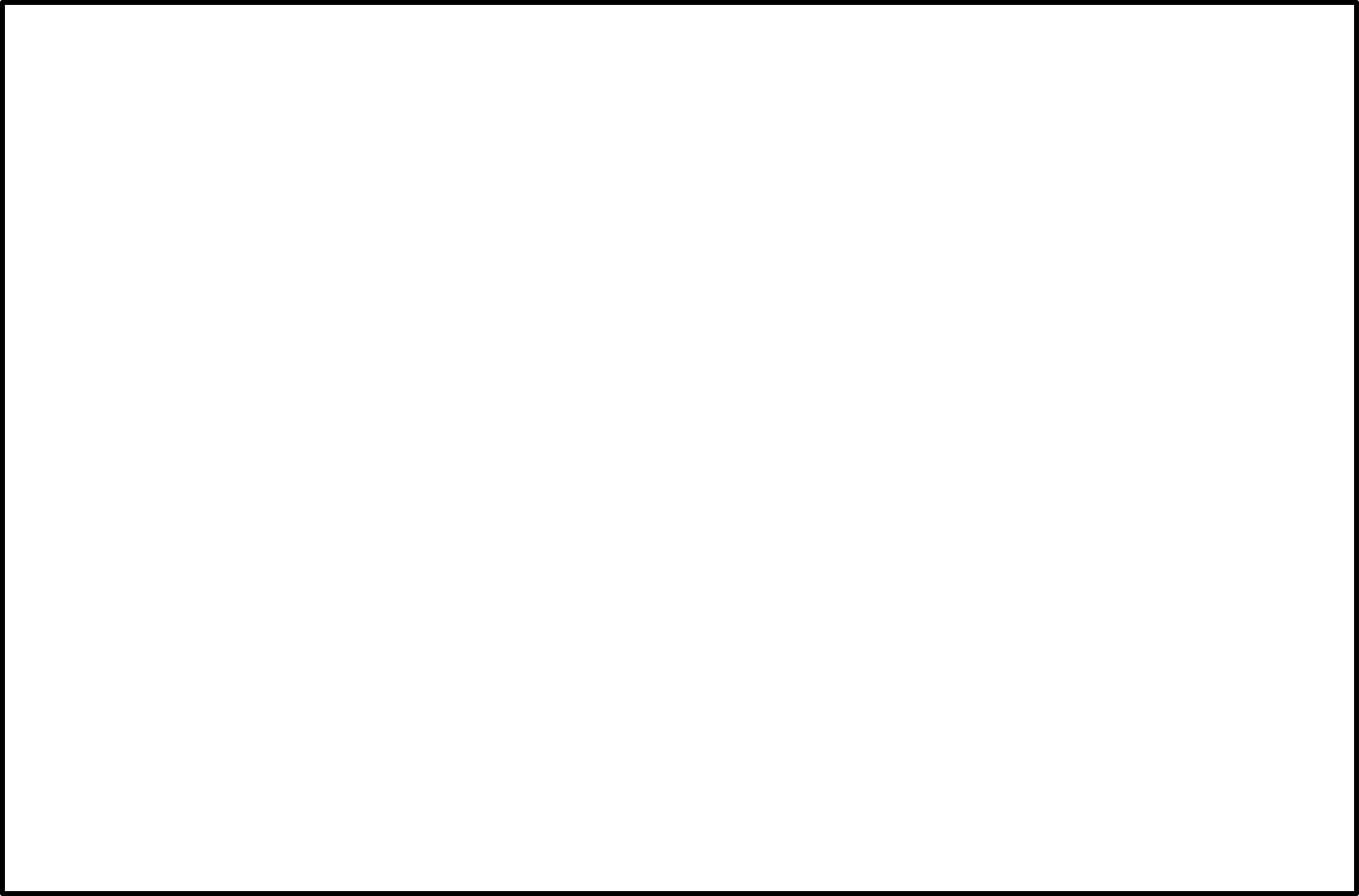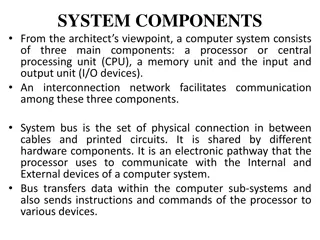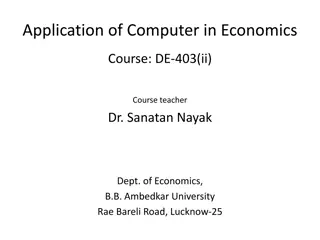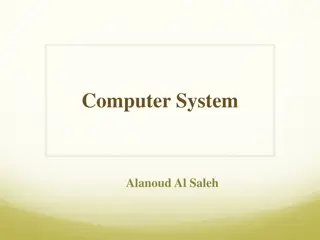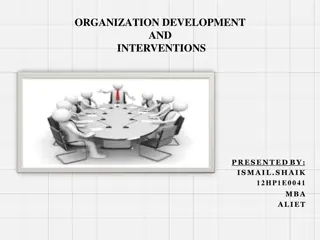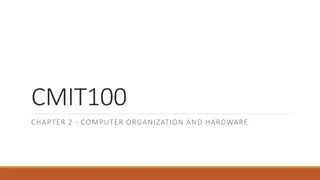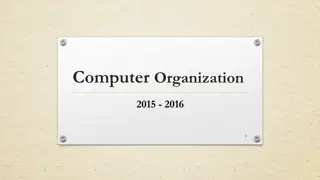Understanding Computer System and Organization
Computer Organization involves the logical structure of a computer, defining the interconnections of components for optimal performance. Computers process data through an Input-Process-Output cycle, with input, processing, and output units working together. The characteristics of a computer include hardware and software components that enable its functionality. Data and information differ in their raw form and processed state, with information being meaningful data. The basic architecture of a computer includes input units responsible for converting input into binary code for processing.
Download Presentation

Please find below an Image/Link to download the presentation.
The content on the website is provided AS IS for your information and personal use only. It may not be sold, licensed, or shared on other websites without obtaining consent from the author. Download presentation by click this link. If you encounter any issues during the download, it is possible that the publisher has removed the file from their server.
E N D
Presentation Transcript
COMPUTER SYSTEM AND ORGANISATION (MODULE 1/6) BY Mrs. SUJATA PRADHAN PGT(SS),AECS,ANUPURAM
Computer Organisation Computer Organisation refers to logical structure of a computer. It defines the interconnection and interdependencies of various components to contribute overall performance of the computer. Computer is an electronic data processing machine which intakes data from the user, processes those data according to the instruction of user and gives desired output. Every task given to a computer follows an Input- Process- Output Cycle (IPO cycle). It needs certain input, processes those input and produces the desired output. The input unit takes the input, the central processing unit does the processing of data and the output unit produces the output. The memory unit holds the data and instructions during the processing. Any digital computer performs four basic funtions. 1.Take data as input 2.Stores data/instructions 3.Process those stored data 4.Generate the output
CHARACTERISTICS OF COMPUTER A computer is the combination of hardware and software. Hardwares are the physical components of a computer like motherboard, memory devices, monitor, keyboard etc. while softwares are the set of programs or instructions that governs the working of computer.Both hardware and software together make the computer system function.
Data and Information What is Data? Data is a raw and unorganized fact that required to be processed to make it meaningful Generally, data comprises facts, observations, numbers, characters, symbols, image, etc.Data is always interpreted, by a human or machine, to derive meaning. What is Information? Information is a set of data which is processed in a meaningful way according to the given requirement. Information is processed, structured, or presented in a given context to make it meaningful and useful. Data is utilized as input and the information is the output of this processing .Information is meaningful, ordered and processed form of data. It is extra important than data because decisions are made by using it. Data and information are interconnected and closely related to each other. Furthermore, Information cannot be compiled without data. Data is an unsystematic, unorganized and unrelated entity. While information is systematized, organized and understandable. Data is independent but the information is dependent. Ex. Students' names in a class are Data While names of students in alphabetic order are Information. A student's subject marks are Data While his percentage of marks, grade and position are Information.
Input Units Input devices connected to a computer system makes its input unit. The input unit is responsible for taking input and converting it into computer understandable form(the binary code).Since computer operates on electricity, it can understand only the language of electricity ON/OFF . i.e. the binary language 1(ON) or 0(OFF). So Input unit is responsible to accept input and to convert it into computer understandable format. Different input devices are used for different types of input. Some of the input devices are as under Mouse Keyboard Microphone Joy-stick OMR MICR Light Pen Scanner Camera
Central processing unit The CPU is called the brain of the computer because it controls the entire computing system.As the CPU is located on a small chip, it is also called the microprocessor. In the CPU, there are three primary components. Arithmetic and Logic Unit (ALU) The ALU, as its name suggests performs mathematical calculations and takes logical decisions. Arithmetic calculations include addition, subtraction, multiplication and division. Logical decisions involve comparison of two data items to see which one is larger or smaller or equal. Control Unit The Control unit coordinates and controls the data flow in and out of CPU and also controls all the operations of ALU, memory registers and also input/output units. It is also responsible for carrying out all the instructions stored in the program. It decodes the fetched instruction, interprets (understands) it and sends control signals to input/output devices until the required operation is done properly by ALU and memory. Memory Registers A register is a temporary unit of memory in the CPU. These receive data/information and then this data/information is held in them as per the requirement. Registers are small unit of data holding places inside CPU.The CPU uses registers to temporarily hold some data during processing.It can be of different sizes(16 bit , 32 bit , 64 bit and so on) and each register inside the CPU has a specific function like storing data, storing an instruction, storing address of a location in memory etc.
OUTPUT UNIT Output devices connected to a computer system makes its output unit.The output coming from CPU is in the form of electronic binary signals which needs to be converted again to human understandable form.i.e. either textual or graphical or audio visual form.It is the responsibility of an Output unit to produce output after processing.Different output devices are used for different types of output.Some of the output devices are Monitor(most common form of output .The screen on monitor is made up of thousands of tiny coloured dots called pixel) Projector Printer Plotter Speaker Headphone
MEMORY UNIT Computer memory is the storage space in the computer, where data is to be processed and instructions required for processing are stored. The memory is divided into large number of small parts called cells. Each location or cell has a unique address. Memory is primarily of three types Cache Memory Primary Memory/Main Memory Secondary Memory Cache Memory: Cache memory is a very high speed semiconductor memory which can speed up the CPU. It acts as a buffer between the CPU and the main memory. It is used to hold those parts of data and program which are most frequently used by the CPU. Advantages 1. Cache memory is faster than main memory. 2. It consumes less access time as compared to main memory. 3. It stores the program that can be executed within a short period of time. 4. It stores data for temporary use. Disadvantages 1. Cache memory has limited capacity. 2. It is very expensive.
Units of Memory: The smallest unit is bit, which mean either 0 or 1. 1 bit = 0 or 1 1 Byte = 8 bit 1 Nibble = 4 bit 1 Kilo Byte = 1024 Byte= 210 Byte 1 Mega Byte = 1024 KB= 210 KB 1 Gega Byte = 1024 MB= 210 MB 1 Tera Byte = 1024 GB= 210 GB 1 Peta Byte =1024 TB= 210 TB 1 Exa Byte =1024 PB= 210 PB 1 Zetta Byte = 1024 EB= 210 EB 1 Yotta Byte = 1024 ZB= 210 ZB
Main Memory Main Memory is often known as Primary memory. Itis not like human memory because data stored in this memory, automatically flushes out with power cut off and can not be recovered later. So it is also known as volatile memory. It is the workplace of a computer system where data is to be kept on temporary basis for the purpose of processing. Every memory location has a definite address. The total time taken to access data from memory is called Memory Access Time . Characteristics of Main Memory These are semiconductor memories. Usually volatile memory. Data is lost in case power is switched off. It is the working memory of the computer. Faster than secondary memories. A computer cannot run without the primary memory.
Secondary Memory Secondary Memory is also known as external memory or non- volatile memory. It is slower than the main memory. These are used for storing data/information permanently. CPU directly does not access these memories, instead they are accessed via input-output routines. The contents of secondary memories are first transferred to the main memory, and then the CPU can access it. For example, disk, CD-ROM, DVD, etc. Characteristics of Secondary Memory These are magnetic and optical memories. It is known as the backup memory. It is a non-volatile memory. Data is permanently stored even if power is switched off. It is used for storage of data in a computer. Computer may run without the secondary memory. Slower than primary memories.
Memory classification Main Memory or primary memory is divided into two types- RAM (Random Access Memory) ROM (Read Only Memory) The memory which is in direct contact of CPU is known as primary memory. RAM and ROM both remains in direct contact of CPU. Random Access Memory (RAM) It is also called as read write memory or the main memory or the primary memory. The programs and data that the CPU requires during execution of a program are stored in this memory.It is a volatile memory as the data loses when the power is turned off. Relatively cheap per megabyte stored compared to ROM, but relatively expensive compared to secondary memory. It is not possible to imagine processing without RAM. The efficiency of RAM depends upon the size (capacity)of RAM.RAM supports both read and write operations. RAM is further classified into two types- SRAM (Static Random Access Memory) and DRAM (Dynamic Random Access Memory).
DRAM AND SRAM DRAM basically consists of transistor and capacitor which stores electric charge.As per switching of Transistor, capacitor may contain a charge (1 bit ) or may not contain a charge(0 bit). DRAM needs to be refreshed again and again which is a tedious job for processor. SRAM is made up of internal Flip-Flops where 1 Flip-Flop is capable of storing 1 bit.It occupies more space as compared to DRAM.It is fast as compared to DRAM.SRAM is expensive as compared to DRAM. Volatile memory is computer memory that requires power to maintain the stored information. Most modern semiconductor volatile memory is either Static RAM or dynamic RAM. Static RAM retains its contents as long as the power is connected and is easy to interface to but uses six transistors per bit. Dynamic RAM is more complicated to interface to and control and needs regular refresh cycles to prevent its contents being lost. However, DRAM uses only one transistor and a capacitor per bit. SRAM is used for cache memories , where DRAM is used as main memory.
ROM ROM (Read Only Memory) stores crucial information essential to operate the system, like the program essential to boot the computer.It is not volatile as always it retains its data.ROM is further classified into 4 types- ROM, PROM, EPROM, and EEPROM. ROM is of following types - ROM (Read Only Memory) PROM (Programmable Read Only Memory) EPROM (Erasable Programmable Read Only Memory) EEPROM(Electrically Erasable Programmable Read Only Memory) Types of Read Only Memory (ROM) PROM (Programmable read-only memory) PROM is different from as a ROM is programmed (i.e. has data written to it) during the manufacturing process, a PROM is manufactured in an empty state and then programmed later using a PROM programmer or user. Once programmed, the data and instructions in it cannot be changed. EPROM (Erasable Programmable read only memory) as the name suggests, data stored in an EPROM can be erased and reprogrammed. Erasing an EPROM involves removing previous data from the computer and exposing it to ultraviolet light before re- burning/reprogramming it. EEPROM (Electrically erasable programmable read only memory) The data can be erased by applying electric field, no need of ultra violet light. We can erase only portions of the chip.
Difference between RAM and ROM Note:The most important things to understand about RAM are that RAM memory is very fast, it can be written to as well as read, it is volatile (so all data stored in RAM memory is lost when it loses power) and, finally, it is very expensive compared to all types of secondary memory . Read-only memory (ROM) is a type of non-volatile memory used in computers and other electronic devices. Data stored in ROM cannot be electronically modified after the manufacture of the memory device. RAM is costlier than ROM as it involves more complex technology to store information & also it is very much faster than ROM.
Storage Unit A secondary storage device refers to any non-volatile storage device that is internal or external to the computer. It can be any storage device beyond the primary storage that enables permanent data storage. A secondary storage device is also known as an auxiliary storage device or external storageIt is required to store data in computer for the purpose of processing in future.Because Primary memory has its own limitations, secondary storage or storage unit is very much required.Secondary storage is used to store large amount of data.Various secondary storage devices are available in market now a days - Hard disk (Internal/External) Pen drive CD DVD Blue Ray Disks Memory Cards Magnetic Tapes
Hard Disk Hard Disk Drives are commonly used as the main storage device in a computer. HDDs often store operating system, software programs and other files. It is a non-volatile memory hardware device that controls the positioning, reading and writing of the hard disk. A hard disk is a sealed unit containing a number of platters in a stack. It can be mounted in a horizontal or a vertical position and electromagnetic read/write heads are positioned above and below each platter. As the platters spin, the drive heads move in toward the center surface and out toward the edge. In this way, the drive heads can reach the entire surface of each platter. Each disk consists of platters, rings on each side of each platter called tracks, and sections within each track called sectors. A sector is the smallest physical storage unit on a disk, almost always 512 bytes in size.
System bus The group of wires used to connect main parts of Computer system is called System Bus which creates an electronic path for the transfer of data. System bus is used to transfer data and instructions between the various components of computer system. The part of System bus that carries data is called Data Bus. The part of System bus that carries instructions is called control bus. The part of System bus that carries memory address is called Address Bus. And the bus connected with input/output units is called I/O bus.





